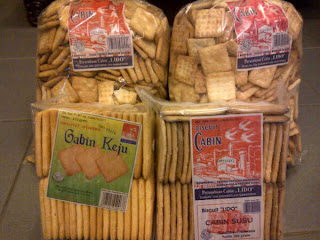1.
Biskuit Gabin
Biskuit gabin or Indonesian hardtack is
made from wheat flour, tapioca flour, margarine, salt, sugar, and milk powder.
Gabin has two main flavors: salty and sweet
(milky). Gabin is usually eaten as the complement when drinking coffee or tea.
People like to dip it into their coffee or tea or any other beverages. The
texture will be a lot softer when it’s dipped.
 |
| Gabin |
Nowadays, gabin comes with many flavors,
not only salty and sweet. Furthermore, it’s also made as something more than
just a biscuit. Indonesian people make lots of creative dishes using gabin that
elaborate the plain taste of gabin while preserving its unique texture.
2.
Kerupuk
Kerupuk or keropok (in Malaysian language) is very widespread in Indonesia.
You can find kerupuk at street vendors to megamalls in Indonesia. No wonder this snack
is very popular, because it has crispy texture, various flavours, and
pocket-friendly price :D. It’s usually eaten along with main dishes. Some
Indonesians say: eating rice without kerupuk is like there’s something missing. However,
I’m not really one of them. J
Kerupuk itself means chip or cracker in
Indonesian, so it’s too general when talking about the taste. There are many
variety of kerupuk in Indonesia, such as:
a.
Kerupuk udang (prawn
cracker)
Kerupuk udang are deep fried crackers made from starch and other
ingredients that usually give the taste. It tastes savory and prawny, for sure.
b.
Kerupuk kulit
People of some regions in Indonesia called kerupuk kulit rambak or
jangek. Kerupuk kulit is made of cow’s or bull’s skin and then seasoned
with spices. After it’s cooked in water, it’s then dehydrated under the sun for
2-3 days. After dried, it’s then deep-fried until crispy and ready to be served
and – absolutely - be eaten.
c.
Kerupuk melarat
Kerupuk melarat or poor’s cracker is one of traditional cracker of
Cirebon (a city in West Java) and nearby areas. This snack is habitually served
as the complement of sambal asam (sour sauce). The best time to eat this cracker
is on dry season. Besides appetizing, it also boosts people’s energy and spirit
to work (I don’t know why, but that’s what people say :p maybe it’s kinda
placebo effect :/).
Kerupuk melarat is made from tapioca flour and other ingredients. It
comes with various colour, ranging from yellow, white, to green.
It’s considered healthy cracker because it’s not cooked with cooking oil,
instead with hot sand which had been cleaned and filtered from any impurity
beforehand. So, it’s good for those who’s suffering from coronary heart disease
or hypertension or diet :p hehe.
d.
Kerupuk gendar or gendar is
made from rice which had been cooked and seasoned. Sometimes, to give it
stretchy texture, people mix it with tapioca flour.
 |
| Kerupuk Gendar |
3.
Amplang
Amplang is a traditional food from Indonesia.
It’s like kerupuk, but it’s actually something different. It’s made
mainly from fish meat and wheat flour. It tastes savory and fishy. The texture
is crispy but a little soggier than regular crackers.
 |
| Amplang |





